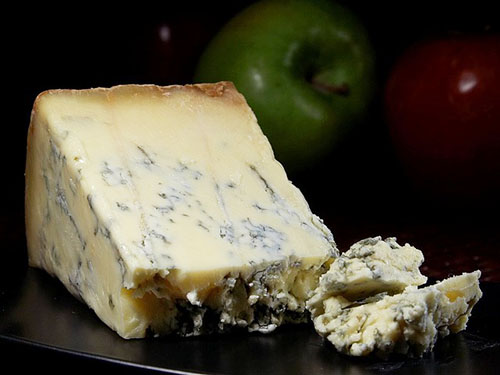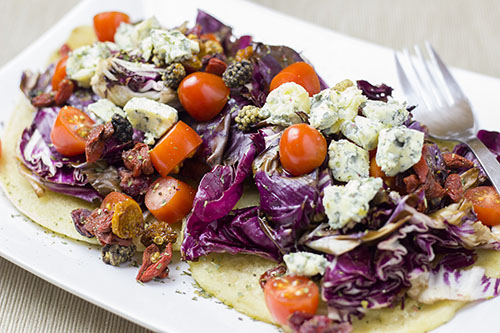Blue cheeses are not only among the most polarizing cheeses, they are among the most polarizing foods.
There are those who love their wonderful funk and bite (myself included), and then there are those who...don’t get it (my younger self included). To move toward a deeper understanding of what these oft-maligned cheeses are all about, I’ve enlisted the help of Michele Molier, Coordinator of Education and Events at NYC’s Murray’s Cheese, who herself admits she wasn’t much of a blue cheese fan until she came to know it better.
“People are turned off by blue cheese for the simple fact that it is blue,” she says. “Other than yellow cheddars, we aren't really used to colors popping up in our cheeses, and the blue mold is easily associated with the blue mold we find in our fridges.”
Related Reading:5 Major Cheese Styles Every Chef Should Know
Blue spoilage mold and the blue cheese mold are different organisms altogether, however, and just one of many ways that blue cheese is often misunderstood. The world of blue cheese is as far-reaching as the world of cheese itself, with varying animal milks, elements of seasonality, and cheesemaking techniques contributing to selections that come from nearly every country that makes cheese, and produce outcomes of flavor and texture that can appeal to blue beginners and thrill-seekers alike.
With Michele’s help, here we get to know some of its defining characteristics, and outline a few selections worth trying for the novice to the fully initiated.
Breaking Down the Mold
First things first, while the folklore of blue cheese suggests that blue cheese began as a mistake (as did all cheese, really), in modern cheesemaking, the making of blue cheese is an extremely controlled and intentional process.
“The main method of making blue cheese is a piercing method,” Michele explains. “This is a bit of a shocker to some people because it’s easier to imagine the cheese being directly injected with blue mold. All blue cheeses start as simple looking white wheels which are then pierced with stainless steel needles that create crevices in order for oxygen to interact with cultures in the cheese and allow the blue mold to grow from within.”
The mold itself is from one or more strains from the genus Penicillium, but contrary to popular myth, these are not the same strains that might become something you take as an antibiotic. (Though I do personally believe in the healing power of blue cheese.)
Shades of Blue
Blue cheese isn’t just one thing, but often in the United States, we’re introduced to a very generic idea of “blue cheese” as something that comes as crumbles or salad dressing, rather than its myriad, artisanal varieties. Blue cheese can be made from cow, goat, sheep or even buffalo milk, which may be raw or pasteurized, resulting in a wide variety of base cheeses before injection even occurs.
Additionally, the diets of the particular animals create variables in cheesemaking, whether they are eating summer grasses or winter hay, and whether those animals are grazing in Ireland or Ecuador, in the mountains or by the sea.

Related Reading:Understand Cheese Rinds
Furthermore, the cheesemaker can affect the outcome of a given blue cheese in terms of how the amount of piercing they do to the wheels, how the cheese is ripened and for how long, whether a rind is allowed to form, and any other treatments they wish to apply to the cheese as it develops. Rogue River Blue, for example, a domestic cheese which won Best Cheese at the World Cheese Awards in 2019 (and was recently served to the President of France), is wrapped in grape leaves that have been soaked in pear liqueur to emphasize certain flavors, literally a “pear-ing” of the cheese.
Outcomes of all of these variables produce blue cheeses that can be downright sweet, to mildly earthy, to bright and peppery, to aggressively “exotic” or “global,” offers Michele, as alternatives to derogatory adjectives to describe blue cheese’s impact.
Pairing the Blues
How you approach eating blue cheese can also affect your enjoyment of it.
As with the crumbles and salad dressings mentioned above, the way we are first often introduced to blue cheese is through salad or wings, both of which have sharp and/or spicy elements which then emphasize those aspects of the cheese as well. Sweet elements such as chocolate, fruits, jams, syrups, and sweet wines can echo the natural sweetness of blue cheese and balance out the sharper and saltier notes, all excellent places to begin for the cautiously blue-curious. Blue cheese on a burger can emphasize its rich and umami characteristics. If the wildness is what you crave, try blue cheese in a salad with equally sharp onions and peppery arugula, or pair it with a dank and hoppy beer.

Starting to Get the Blues
“For a novice who doesn't think they like blue cheese, get started on Bailey Hazen Blue, from Jasper Hill Farm in Vermont or Persille de Rambouillet from France,” Michele suggests. “Both of these cheeses have a super friendly white paste that is reminiscent of ice cream or a fluffy cottage cheese. Neither has aggressive blue molding, and you can even eat your way around the blue if you absolutely have to.”
If these aren’t available, you can always ask your cheesemonger for other sweeter, subtler blues to begin with, or for selections or pieces of wheels that have less blue veining. Other easy-going blues include Gorgonzola dolce (Italy), Cambozola (Germany), St. Agur (France) and Cashel Blue (Ireland).
If you think you already have some taste for blue cheese and want to expand your palate, Michele points to California, whose creameries helped to put U.S. blue cheese-making on the world map.
“Point Reyes Original Blue is a great cheese for seasoned blue cheese eater[s]," she says. "It's made with raw cow's milk, giving extra edge to the wheel right away. Each wheel is different but there is generally a large amount of blue molding and each bite will have crumbles of peppery blue/green mold, which complements its super rich paste.”
Also look for other blues that have variations on the process, many of which are made domestically where ancient food rules do not apply such as Rogue River Blue (Oregon), Big Rock Blue (California), Maytag (Iowa) and Arethusa Blue (Connecticut).
And finally, for those who think they can dive the deep blue hole: “Go Roquefort or go home,” Michele says. “This French blue cheese sets the mold for all blue cheeses after it. It is a sheep's milk blue cheese, so you're going to get some additional body and meatiness from the milk alone. The secondary culture in this cheese is Pencillium Roqueforti, and it’s this culture that gave the cheese its name. It's punchy, salty and all around mind-blowing. If you're enjoying this cheese on a cheese board or at a party, be sure to eat it last. You may not be able to taste anything afterwards!”
Other bad boy blues include heavy hitters from England such as Stilton and Shropshire Blue.
More Fundamentals of Cheese:






